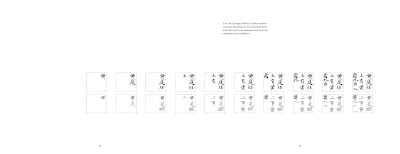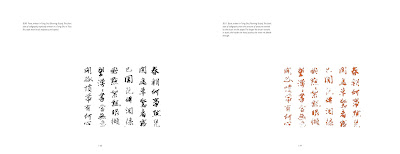A list of terms used in the thesis
Calligraphy,书法 Shu Fa
Shu: book, document, style, write
Fa: method, law, magic, the Way
There is a specific ‘fa’ for every style of calligraphy
Stroke Order
The predetermined pattern of stroke placement for a Chinese character
Semantic
Meaning in language
Radical
Units of meaning, usually a reductive character form
Pictograph
A diagram of living things and objects
e.g. Fu (Broom) is a diagram of the ceremonial broom that splash wine over the altar
Semantic Combination
A new word as a result of pictograph combinations
e.g. Gui (Return) is a combination of the ceremonial broom and the meat offering prior to the troops’ departure
Ideogram
A character symbolizing the idea of a thing without indicating the sequence of sounds in its name
e.g. A position or direction such as Shang (Up) or Xia, (Down)
Phonetic Borrowing
Apply the sound of one character to another without the consideration for meaning.
e.g. Wo (First person “I”) is a borrowed homophonous of Wo,(A Saw)
Semantic Phonetic
A character that relies on one component to indicate sound and the other component to indicate meaning
e.g. Yi (Ant) is a combination of the phonetic yi (righteousness) and the semantic radical for insect
Extended Meaning:
Characters with different configuration and pronunciation but a shared logic because of a common semantic unit
e.g. Fu (Broom), Sao (Clean), Jin (Soak)
Chinese Character:
A configuration of forms that stands as both a symbol of meaning and sound, and incorporates all parts of speech
Significant Form:
“Incorporates elements of both imagery (generalized simulation), and expressiveness (of emotions).” (Li, 38)
The Laws of Form (as defined by Li Zehou)
rhythm,
rhyme,
symmetry,
balance,
continuity,
intermission,
overlapping,
singleness,
thickness,
density,
repetition,
intersection,
complexity,
consistency,
change,
unity.
Calligraphic Styles
Hsiao Chuan or Xiao Zhuan
Small Seal Script, 221-201 B.C.
Li Shu
Clerical Script, 221-201 B.C.
Chen Shu or Zhen Shu, Kai Shu
Standard Script, Block Script 70 A.D.
Tsing Shu or Xing Shu
Running Script, 220 A.D.
Tsao Shu or Cao Shu
Cursive Script, 45-33 A.D.
Calligraphic Strokes
Ts’e or Dian
A spot or a motion similar to slant
Lo or Heng
A horizontal stroke or a motion similar to bridle
Nu or Shu
A vertical Stroke or a motion similar to strive
Yo or Gou
A hook or a motion similar to spring
Tse or Ti
A diagonal stroke that starts from the bottom left to upper right or a motion similar to whip
Cho or Pie
A short diagonal stroke that starts from the upper right to bottom left or a motion similar to peck
Lueh or Pie,
A long diagonal stroke that starts from upper right to bottom left, or a motion similar to skim
Chih or Na
A long diagonal stroke that starts from upper left to bottom right, or a motion similar to tear
Sentence Structure
Agent Act Object
Agent is a thing poised for action
Act is what passes between
Object possess latent action
Transitive
In grammar, are verbs that take a direct subject or object. The meaning of transitive verb is incomplete without the object.
Intransitive
In grammar, are verbs that describe states and do not take a subject.
Metaphor:
“The use of material images to suggest immaterial relations.” (Fenollosa, p26)
Shi:
Position and potential
The meaning as position derives from the character as an ideogram, “which is believed to represent a hand holding something, a symbol of power to which the diacritic radical for force (li) was later added. Xu Shen thinks what is held in the hand is a clod of earth, which symbolize something put in position or a “positioning.” (Jullien, p267)
The meaning as potential comes from phonetic borrowing, “in terms of its spatial connotation, corresponds to the word shi, which its temporal associations in the sense of “opportunity” or “chance.”(Jullien, p267)
Position
A configuration or arrangement
Potential
Opportunity that arise out of the tension created between elements within the configuration







































































